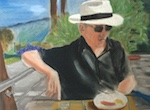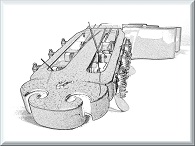Welcome to one of the most active flamenco sites on the Internet. Guests can read most posts but if you want to participate click here to register.
This site is dedicated to the memory of Paco de Lucía, Ron Mitchell, Guy Williams, Linda Elvira, Philip John Lee, Craig Eros, Ben Woods, David Serva and Tom Blackshear who went ahead of us.
We receive 12,200 visitors a month from 200 countries and 1.7 million page impressions a year. To advertise on this site please contact us.
|

|
|
RE: blanca with cedar top?
|
You are logged in as Guest
|
|
Users viewing this topic: none
|
|
Login  | |
|

   
estebanana
Posts: 9358
Joined: Oct. 16 2009

|
 RE: blanca with cedar top? (in reply to Tom Blackshear) RE: blanca with cedar top? (in reply to Tom Blackshear)
|
|
|
quote:
Eugene Clark was telling me over the phone today that Borax soap, heated and mixed with blond shellac, will flatten out the dark color of some cedar tops.
If you mix borax with your shellac you'll dissolve the shellac. He must have meant something else.
He bleaches shellac to remove the yellow from the spectrum and it renders a more honey colored shellac, but advocating putting borax your shellac is a situation that could become problematic. Bleaching your own shellac is a tricky process unless some one shows you how to do it.
I hope no one, misunderstands what I'm saying. I'm not against using color, but I think a lot of what gets called 'color matching' is really the effect of colored finish equalizing two different woods because the color in the finish is a essentially light wave filter. You can layer a bit more colored finish on the top and it appears to to filter more light and makes the two woods looker closer in value because the finish is filtering out some frequencies of light, but it's not color matching. It's not color matching, but using the color in the finish to equalize the amount of light shining through the finish film and reflecting back out.
it's about making the values of the different shades of wood on the guitar appear to be the same. I think it has certain falsehood to one generation than the other. I like the wood to be what it is and express itself naturally. Unless I can find or make a stunning golden brown color I find the darker shellac colors to be garish and too red or too yellow. On a violin, viola or cello a multi layered colored varnish varnish is a beautiful thing, but even in that history of instrument making color matching between back and top was not generally a consideration. They just layered colored varnish on to serve as a protective coating and to provide some damping that takes off the harsh edges of the instrument. In addition to that the varnish had to be flexible enough to allow the instrument to vibrate.
Which has led me to experiment away from color and hardness in finishes, the two things guitar maker obsess over, and begin to think about flexibility. I've started to finish the backs and sides on a few blancas with varnish and only French polish the tops. Color matching does not concern me at all or for that matter even using and color in the varnish. The wood on it's own is stunning under varnish.
Guitarists have also been conditioned to expect a uniform even coating of color, this is achievable if you apply yourself to the process, but I find it boring after having worked in a two violin shops and having varnished several cellos when I was younger. The violin world musician is not stricken with the same obsessive compulsion to have every thing on the instrument be glassy smooth and characterless. Sometimes I look at guitars and I think to myself the finish looks like a cheap slick car finish. Or an expensive slick car finish. Personally I think the slickness works on metal cars better than wood. A state of slickness is more suited to metal as a material than wood. I muse a lot over why violinists are keen on the irregularity and organic incident in a violin varnish while guitarists seem to like monochrome fields of slick surface.
It could be because violins have arching and curved edges, while guitars are comprised of more or less flat planes of wood with corner like edges. But I still wonder what a world full of more organically finished softer glowing guitars would hurt? If I were to become intrigued with working in depth with color on a guitar I would want the customers permission to layer color not with the intent of making everything look the same, but possibly bringing out the differences of the various woods even more.
Like why can't a guitar have beautifully clear coated back and sides and then a layered top with two deep colors of finish to make it flash dichroically? Making things even out or be the same seems so boring, why can't we accentuate the individual qualities of the woods we use? We can, someone just has to do it first and then let it catch on. The steel string and electric guitar worlds and the violin world does it, why does the classical/flamenco guitar world have to stay in this mono chromatic, slick, glassy box?
_____________________________
https://www.stephenfaulkguitars.com
|
|
|
|
REPORT THIS POST AS INAPPROPRIATE |
Date Nov. 5 2011 19:06:31
 |
|

   
Tom Blackshear
Posts: 2304
Joined: Apr. 15 2008

|
 RE: blanca with cedar top? (in reply to Anders Eliasson) RE: blanca with cedar top? (in reply to Anders Eliasson)
|
|
|
quote:
ORIGINAL: Anders Eliasson
quote:
Also, I still have some of the old school shellac with color, called Gomo Laca,
All shellack is called Goma laca in Spain, being old school, modern school, futuristic schoo.l whatever. The thing is that Goma Laca means..... shellack.
Yes, and in Mexico they call it varnish con gasolina, which some builders in the US thought it meant to use gasoline with shellac. I mentoned the Goma Laca, as that was what it was called on the packaging.
And perhaps I should have said that the "tan colored" Goma Laca mix is not supplied by the finishing houses anymore, which had a beautiful tan appearance. And the way it looks, most of the mix going to builders is more yellow these days.
The 2003 Reyes guitar I looked at had a yellow cast which seemed to be more like most other blond shellac; even the mix that I get from my supplier.
In other words, I implied that the old Goma Laca was ready to use to create tan color to where the blond shellac needs some alteration to make it more tan in its coloration. I hope this better explains it for you.
I understand that you speak English better than I speak Spanish but I think perhaps you miss some of my explanations a little, on occasion.
_____________________________
Tom Blackshear Guitar maker
|
|
|
|
REPORT THIS POST AS INAPPROPRIATE |
Date Nov. 5 2011 22:17:40
 |
|

   
Tom Blackshear
Posts: 2304
Joined: Apr. 15 2008

|
 RE: blanca with cedar top? (in reply to estebanana) RE: blanca with cedar top? (in reply to estebanana)
|
|
|
quote:
He does not teach by rote in that you have to have to slavishly copy him. He gives the conceptual framework and points out the subtle ways to thinking about every part of the guitar. I took in as much of it as I possibly could and then made it my own. It's what good students do.
What you say here, I agree with, in principle. I've made replicas of many of the old masters in my life time of building but I see what they did and then refer to my own feel for the way to communicate it's voice and articulation.
I built replicas for the plain and simple reasoning that I'm an analytically minded person and sought to find the codes of each master guitar maker for my own personal satisfaction.
In doing this, I have accumulated much knowledge as a self taught builder of over 50 years.
I decided to donate my plan of the 2003 Reyes flamenco guitar to the GAL for the specific purpose for this to be a starting point for some builders but what actually happened was that professional builders, along with students, ordered the plan from the GAL and built it with their professional skills to see what it produced. Well, I can tell you now, that every e-mail that I received from builders world-wide had nothing but positive things to say about it.
Should we stop here, absolutely not, but this was my small contribution to the builders of this world, with the idea of leveling the playing field for those builders who didn't have the advantage of a teacher like Eugene Clark to help them along the way.
All printed patterns of the builders that have gone before us are available for information to those who care to try them out. This was no different for my effort. And I may or may not try something like this again, perhaps with an older Conde model.
The essential elements of building are known by this writer with many years of experience but I would be way out of place to think I knew it all. Everyone here has something to share for the benefit of every guitar builder, and I wouldn't doubt, some newer innovation that could benefit us all.
I was approached by a well known builder many years ago, and he said, "Tom, you've worked hard to gain knowledge all of these years and why do you want to just give it away?" My answer to him was that he and another well known builder had shown me no information, and that this was my own finding, and if I wanted to give it away, then that was my business. He accepted that graciously.
Well, I don't give everything away but I feel this was my small offer of help to those who were struggling to find the answers to build a good guitar. And of course, this is not the only way to build a guitar but it was genuinely offered as a gift to the GAL and to those who felt the need to use it.
_____________________________
Tom Blackshear Guitar maker
|
|
|
|
REPORT THIS POST AS INAPPROPRIATE |
Date Nov. 6 2011 14:13:52
 |
|
 New Messages New Messages |
 No New Messages No New Messages |
 Hot Topic w/ New Messages Hot Topic w/ New Messages |
 Hot Topic w/o New Messages Hot Topic w/o New Messages |
 Locked w/ New Messages Locked w/ New Messages |
 Locked w/o New Messages Locked w/o New Messages |
|
 Post New Thread
Post New Thread
 Reply to Message
Reply to Message
 Post New Poll
Post New Poll
 Submit Vote
Submit Vote
 Delete My Own Post
Delete My Own Post
 Delete My Own Thread
Delete My Own Thread
 Rate Posts
Rate Posts
|
|
|
Forum Software powered by ASP Playground Advanced Edition 2.0.5
Copyright © 2000 - 2003 ASPPlayground.NET |
9.399414E-02 secs.
|


 Printable Version
Printable Version









 New Messages
New Messages No New Messages
No New Messages Hot Topic w/ New Messages
Hot Topic w/ New Messages Hot Topic w/o New Messages
Hot Topic w/o New Messages Locked w/ New Messages
Locked w/ New Messages Locked w/o New Messages
Locked w/o New Messages Post New Thread
Post New Thread